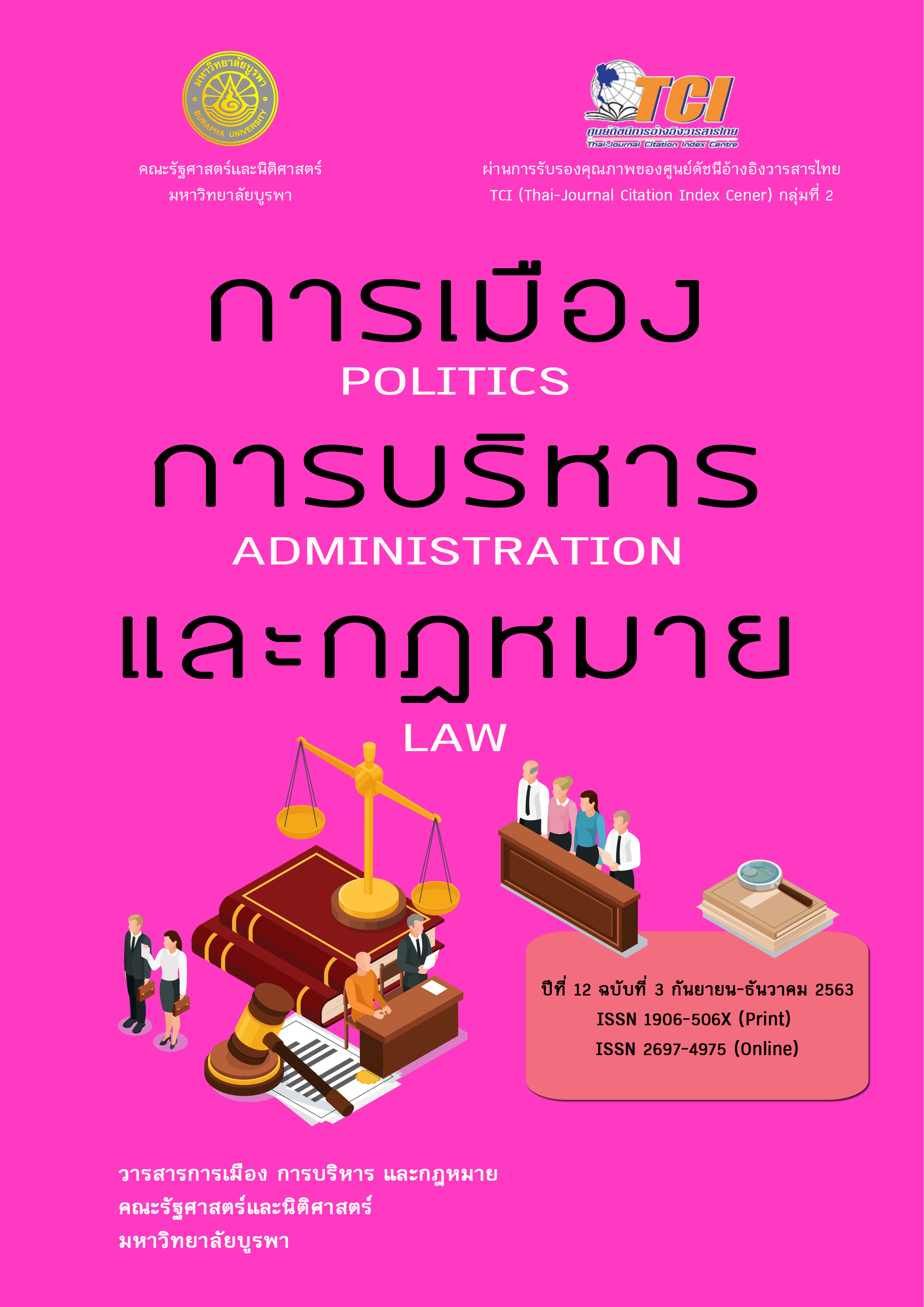The Elements of Administrative Effectiveness to Rehabilitate the Children and Youth Who Commit Crimes in the Justice System
Keywords:
The administrative effectiveness, Rehabilitate the children and youth, Commit Crimes, Justice SystemAbstract
The purposes of this study were 1) To Study the elements of the effectiveness of the administration to correct, rehabilitate the children and youth who commit the crimes in the justice system 2) To check the compatibility of the elements of the effectiveness of the administration to correct, rehabilitate the children and youth who commit the crimes in the justice system 3) To study the problems, obstacles and finding the solutions to correct, rehabilitate the children and youth who commit the crimes in the justice system by using the mixed research methods in term of sequential design. The descriptive quantitative used a research questionnaire as a tool to collect the information from 235 person by cluster sampling. The data were analyzed by the exploratory factor analysis: EFA, confirmatory factor analysis: CFA. The qualitative research was performed by the interviewing using the key information follow the evaluation for each element of Stufflebeam from 10 person by purposive sampling. The result reveals there were 8 elements as follows 1) The organization’s structure 2) The information technology 3) The organization culture 4) The executive leadership 5) The communication 6) The strategic management 7) The organizational commitment 8) The organization environment that effect to the administration to correct, rehabilitate the children and youth who commit the crimes in the justice system which is a harmonious index by the empirical data statistical significance at the level 0.01 (2 = 19.07, df = 15, 2/df = 1.27, p-value = 0.21, GFI = 0.98, AGFI = 0.95, RMR = 0.01, RMSEA = 0.03 and CN = 372.61). This result correlate to the principle of accuracy and coverage usefulness, appropriateness and possibility of using 80.00 percent or more. In part of the problems and obstacle in the administrative management, solution were found 3 categories as follows; 1. Personnel problems, a psychologist workforce should be increased and promote to construct the solution to select the judge to taking the position in the juvenile and family court by the appropriated specific expertise and knowledge. Moreover, the standard operation process for the officer should be constructed. 2. Information and tool, the budget should be increased and the officer should be trained to use the rehabilitate the children and youth who commit the crimes information and technology. 3. Cooperation, the cooperation network between other institutions such as school, temple, and community and so on should be constructed to learn and practice to rehabilitate the children and youth who commit the crimes together with their parents including making an understanding between the children, parents and communities by using of the public relation.
References
พรไชย วงศ์เมธานุเคราะห์. (2551). แนวคิดการพัฒนาศาลเยาวชนและครอบครัว. กรุงเทพฯ: สถาบันพัฒนาข้าราชการฝ่ายตุลาการศาลยุติธรรม.
พระราชบัญญัติศาลเยาวชนและครอบครัวและวิธีพิจารณาคดีเยาวชนและครอบครัว พ.ศ. 2553. (2553, 22 พฤศจิกายน). ราชกิจจานุเบกษา. หน้า 12-73.
พิรุณ เรืองไพศาล. (2558). การพัฒนารูปแบบการบริหารโรงเรียนคาทอลิกที่มีประสิทธิผล. ปรัชญาการศึกษาดุษฎีบัณฑิต, สาขาวิชาการบริหารและพัฒนาการศึกษา, มหาวิทยาลัยมหาสารคาม.
วัจนาถ วังตาล. (2553). บทบาทของศาลเยาวชนและครอบครัวกับการแก้ไขบำบัดฟื้นฟูจำเลยในคดีอาญา. กรุงเทพฯ: สถาบันพัฒนาข้าราชการฝ่ายตุลาการศาลยุติธรรม.
ศิริวรรณ เสรีรัตน์ และคณะ. (2546). การบริหารเชิงกลยุทธ์และกรณีศึกษา. กรุงเทพ: บริษัทธรรมสาร จำกัด.
สมหมาย เทียนสมใจ. (2556). รูปแบบการบริหารงานที่มีประสิทธิผลของสำนักงานเขตพื้นที่การศึกษาประถมศึกษา. ดุษฎีนิพนธ์ปรัชญาดุษฎีบัณฑิต สาขาการบริหารการศึกษา, บัณฑิตวิทยาลัย, มหาวิทยาลัยศิลปากร.
สุภมาส อังศุโชติ, สมถวิล วิจิตรวรรณา และรัชนีกูล ภิญโญภานุวัฒน์. (2557). สถิติวิเคราะห์สำหรับการวิจัยทางสังคมศาสตร์และพฤติกรรมศาสตร์:เทคนิคการใช้โปรแกรม LISREL (พิมพ์ครั้งที่ 2). กรุงเทพฯ: เจริญดีมั่นคงการพิมพ์.
เอมอร พลวัฒนกุล. (2557). องค์ประกอบประสิทธิผลองค์การจัดเก็บภาษีกรมสรรพากรในประเทศไทย. วารสารวิทยาลัยพาณิชยศาสตร์บูรพาปริทัศน์, 9(2), 97-109.
Creswell, J. W. (2013). Research Design: Qualitative, Quantitative, and Mixed Methods Approaches. (2nd ed.). Thousand Oaks, CA: Sage publications.
Denhardt, J, V., & Denhardt, R. B. (2007). The New Public Service. New York: M.E. Sharpe, Inc.
Gibson, J. L. (2000). Organizations:Behavior Structure Process (10th ed.). Boston: McGraw - Hill.
Hair, et al. (2014). Multivariate data analysis: a global perspective (7th ed.). Upper Saddle River: Prentice-Hall.
Joreskog, K. G., & Sorbom, D. (1996). LISREL8: User’s Reference Guide. Chicago: Scientific Software International.
Steers, R. M. (1977). Organizationl Effectiveness: A Behavioral View. Santa Monica, Califonia: Good Year Publishing Company.
Stufflebeam, D. L. (1971). Educational Evaluation and Decision Making Itasca. Illinois: Peacock.






